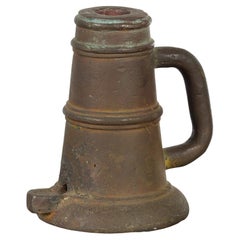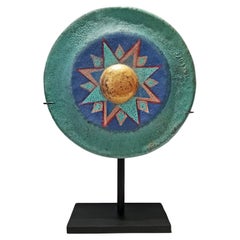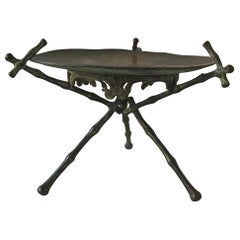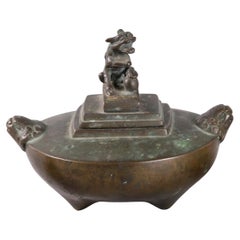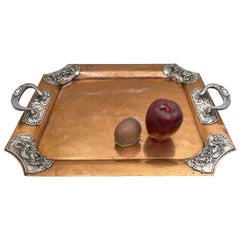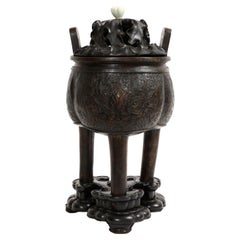Tri-State Area - Metalwork
to
34
274
1,054
608
274
1
1
1
18
156
100
56
28
11
5
3
5
1
4
1
4
2
1
268
158
68
61
26
254
222
154
68
16
274
274
274
1
1
1
Item Ships From: Tri-State Area
Indian Antique Smelting Pot with Back Handle, Front Spout and Weathered Patina
Located in Yonkers, NY
An Indian antique smelting pot from the 19th century, with back handle, front spout and nice patina. Created in India during the 19th century, th...
Category
19th Century Indian Antique Tri-State Area - Metalwork
Materials
Iron
Indonesian Gong on Stand, Mid-20th Century
Located in New York, NY
A vintage Indonesian gong, polychromed and repurposed for a freestanding sculpture. Mounted on a black metal stand. Circa 1940. The front is painted i...
Category
1940s Indonesian Other Vintage Tri-State Area - Metalwork
Materials
Metal
1920s Copper Stamped Dish Or Disc With Patina On Copper Faux Bamboo Stand
Located in Tarrytown, NY
This unique 1920s Copper Stamped Dish Or Disc With Patina On Copper Faux Bamboo Stand has a variety of uses as well as being decorative.
It's size is perfect to act as a vide poche, tabletop...
Category
1920s Vintage Tri-State Area - Metalwork
Materials
Copper
Chinese bronze censer, 19th c.
Located in New York, NY
cover surmounted by a foo lion
Category
Late 19th Century Chinese Antique Tri-State Area - Metalwork
Materials
Bronze
Japanese Mixed Metal Silver on Copper Tray with Dragon Motifs
Located in New York, NY
Japanese mixed metal copper and silver two-handled tray, from the late 19th or early 20th century, beautifully adorned with dragon motifs in relief on the rim and handles. It measure...
Category
Early 20th Century Japanese Tri-State Area - Metalwork
Materials
Silver, Copper
17th Century Chinese Bronze Censer & Cover with Jade Finial Top and Wood Base
Located in New York, NY
A Fantastic and Rare 17th century Chinese Patinated Bronze Censer & Cover with Jade Finial Top and Wood Base. The body of this censor is intricately decorated with Archaistic decoration in hand-chassed relief. The wooden lid is designed with a foliate, leaf-like form, with a gorgeous white jade finial in the shape of a lotus leaf. The gorgeous tripod censer stands...
Category
1690s Chinese Qing Antique Tri-State Area - Metalwork
Materials
Bronze
Set of Three Vintage Indian Metal Vessels with Weathered Patina
Located in Yonkers, NY
A set of three vintage Indian metal vessels from 20th century, with weathered patina. We have more sets available. Created in India during the 20th centur...
Category
20th Century Indian Tri-State Area - Metalwork
Materials
Metal
Bronze Table Lamp in the Style of James Mont
Located in Tarrytown, NY
Large patinated bronze lamp with butterfly details.
Solid wood base.
Professionally restored and rewired.
Double socket with pull chains. Adjustable.
Capacity: 2 x E26 per lamp.
Category
1960s Chinese Vintage Tri-State Area - Metalwork
Materials
Bronze
Burmese 19th Century Bronze Ceremonial Bell with Verde Patina and Cow Motif
Located in Yonkers, NY
An antique Burmese bronze ceremonial bell from the 19th century with verde patina and cow motif. Created in Burma during the 19th century, this bronze ceremonial bell will make for a...
Category
19th Century Burmese Antique Tri-State Area - Metalwork
Materials
Bronze
pair of Chinese cloisonné bottle vases
Located in New York, NY
floral motif on yellow ground
Category
Late 20th Century Chinese Tri-State Area - Metalwork
Materials
Metal, Enamel
$3,500 / set
Vintage Hand Painted Blue Metal Vase with Calligraphy and Floral Décor
Located in Yonkers, NY
A vintage hand painted blue metal vase from the mid-20th century with calligraphy and floral décor. Crafted during the midcentury period, this charming hand-painted blue metal vase c...
Category
Mid-20th Century Chinese Tri-State Area - Metalwork
Materials
Metal
Celebes Island Hand-Tooled Temple Monster Sculpture with Swine Ears and Horn
Located in Yonkers, NY
An Indonesian hand-tooled metal sculpture from the Celebes Island depicting a temple monster with swine ears and legs, horn, tail and a bell around his collar. Created on the Indones...
Category
19th Century Indonesian Antique Tri-State Area - Metalwork
Materials
Metal
Pair of Chinese Double Gourd Cloisonné Cover Vases
Located in New York, NY
provenance: Christie's; wooden bases shown in pictures are included with these vases; each vase is decorated with miniature gourds in relief; overall size of each vase with wooden ba...
Category
Early 20th Century Chinese Tri-State Area - Metalwork
Materials
Metal, Enamel
$20,000 / set
Japanese Bronze Floor Vase with Owl Figures
Located in Queens, NY
Asian Japanese bronze floor vase with 2 owls figures standing on branches with a leaf relief around a round base.
Category
19th Century Japanese Antique Tri-State Area - Metalwork
Materials
Bronze
Pair of Chinese Cloisonné Elephants, Each On Its Original Cloisonné Base
Located in New York, NY
each elephant is surmounted by a vase filled with various ornaments
Category
Early 20th Century Chinese Tri-State Area - Metalwork
Materials
Metal, Enamel
A Japanese Bronze Vase With Applied Lotus Leaf Design
Located in Stamford, CT
A Japanese patinated bronze vase with alternating lotus leaf design. Meiji Period
Category
19th Century Japanese Meiji Antique Tri-State Area - Metalwork
Materials
Bronze
Pink & Green Antique Chinese Peking Enamel Cups and Dishes w. Floral Decoration
Located in Morristown, NJ
19th/20th c., Chinese enamelware, includes (2) cups and (2) small scalloped edge dishes, each with enameled floral design on a copper ground, unmarked.
This type of enamelling is known by several names, including Beijing, Canton and Peking enamel...
Category
Late 19th Century Chinese Chinese Export Antique Tri-State Area - Metalwork
Materials
Enamel
Chinese cloisonné cover jar
Located in New York, NY
decorated with antique objects on pale blue ground
Category
Late 20th Century Chinese Tri-State Area - Metalwork
Materials
Metal, Enamel
Fine Quality Japanese Meiji Chrysanthemum Silver Incense Burner
Located in New York, NY
Fine quality Japanese Meiji silver incense burner, ca 1890. Barrel-form with solid top and bottom and open sides; applied chrysanthemums heightened with gold and silver. Cover oval a...
Category
Late 19th Century Japanese Meiji Antique Tri-State Area - Metalwork
Materials
Silver
French Patinated Bronze Figure of a Standing Japanese Geisha with Kimono & Obi
Located in New York, NY
A beautiful French patinated bronze figure of a standing Japanese geisha in a traditional kimono with an obi. This geisha is exceptionally cast with immense detail. Starting from the...
Category
Early 20th Century French Japonisme Tri-State Area - Metalwork
Materials
Bronze
Pair of Chinese Cloisonné Bottle Vases
Located in New York, NY
peach motif on yellow ground
Category
Mid-20th Century Chinese Tri-State Area - Metalwork
Materials
Metal, Enamel
$10,000 / set
Archaic Bronze Vessel in Flattened Flask Form
Located in Stamford, CT
An archaic bronze vessel in flattened flask form with ring handles and mottled red and green patination.
Category
15th Century and Earlier Chinese Antique Tri-State Area - Metalwork
Materials
Bronze
Silver Fan Holder, 19th Century
Located in New York, NY
An exquisitely carved silver fan holder, India, late 19th century.
Category
1890s Indian Agra Antique Tri-State Area - Metalwork
Materials
Silver
A Japanese Bronze of a Bactrian Camel
Located in Stamford, CT
A sculpted Japanese bronze of a Bactrian camel.
Category
Early 1900s Japanese Showa Antique Tri-State Area - Metalwork
Materials
Bronze
John Bradstreet Bronze Lotus, circa 1900
By John Scott Bradstreet
Located in New York, NY
From the 1890s until his death in 1914, John Bradstreet, the important American Arts and Crafts furniture and interior designer, worked from The Crafts House, his landscaped orientalist compound in Downtown Minneapolis. There, he also received his clients, and dealt in Asian art acquired on frequent trips to the Far East. He used similar bronze Japanese lotuses...
Category
Early 1900s American Arts and Crafts Antique Tri-State Area - Metalwork
Materials
Bronze
Chinese cloisonné shrine/stupa
Located in New York, NY
decorated in relief; floral motif on yellow ground
Category
Late 20th Century Chinese Tri-State Area - Metalwork
Materials
Metal
Japanese Meiji Period Bronze and Champlevé Enameled Censer
Located in Long Island City, NY
This Japanese censer incense burner, inspired by Chinese pieces, is of spheroidal form, the bronze body with polychrome champlevé enamel work flanked b...
Category
Early 1900s Japanese Meiji Antique Tri-State Area - Metalwork
Materials
Bronze
Pair of Chinese Cloisonné Deer
Located in New York, NY
decorated with stylized scrolls on blue ground
Category
Mid-20th Century Chinese Tri-State Area - Metalwork
Materials
Metal, Enamel
$12,000 / set
Chinese Gu Vase
Located in Stamford, CT
A bronze Chinese Gu vase.
Category
18th Century and Earlier Chinese Antique Tri-State Area - Metalwork
Materials
Bronze
$2,800
Antique Chinese Silver Gilt, Agate & Enamel Censer
Located in New York, NY
Chinese silver censer, circa 1910. Drum-form agate body set in silver gilt mounts with scrollwork and lunettes. Leaf-capped side bracket handles. Upward tapering support and stepped ...
Category
Early 20th Century Chinese Qing Tri-State Area - Metalwork
Materials
Agate, Silver, Enamel
Chinese cloisonné square-shaped vase
Located in New York, NY
archaistic motif on blue ground
Category
Late 20th Century Chinese Tri-State Area - Metalwork
Materials
Metal
Pair of Japanese Edo Period Iron Silver Inlaid Red Lacquered Stirrups 'Abumi'
Located in New York, NY
A Pair of Japanese Edo Period (1603–1867) iron, silver inlaid, and red lacquered stirrups (Abumi). Each of typical form, made of iron with silver inlay on the front with floral bloss...
Category
1690s Japanese Edo Antique Tri-State Area - Metalwork
Materials
Silver, Iron
Japanese Bronze Vase
Located in Stamford, CT
A Japanese patinated bronze vase of outstanding color with a lotus bud form top.
Category
19th Century Japanese Antique Tri-State Area - Metalwork
Materials
Bronze
$7,800
A Monumental Gilt-Lacquered Bronze Ornamental Buddha Sculpture of Vajravidarana
Located in Queens, NY
A Monumental Gilt-Lacquered Bronze Ornamental Buddha Sculpture of Vajravidarana:
A Masterpiece of Sino-Tibetan Craftsmanship, Late 19th Century, Qing Dynasty
This monumental gilt-lacquered bronze ornamental sculpture of Vajravidarana is an extraordinary and commanding piece of art, showcasing the pinnacle of Sino-Tibetan craftsmanship from the late 19th century. The figure of Vajravidarana, a powerful purification deity in Tibetan Buddhism, is meticulously sculpted to embody both spiritual authority and artistic excellence.
Vajravidarana is primarily known for his role in removing spiritual impurities and negativities. Unlike other deities associated with wisdom or compassion, Vajravidarana’s function is centered on purification and healing. He is typically depicted holding a vajra and a bell, symbolizing the cutting away of delusions and the resonance of divine truth. In this striking sculpture, Vajravidarana is shown holding a vishva vajra (the double vajra), a unique and powerful variation of the traditional iconography, which signifies ultimate protection and the dispelling of negative karma.
Vajravidarana: The Supreme Purifier and Protector
Vajravidarana is revered in Tibetan Buddhism as the deity of spiritual purification, called upon to cleanse practitioners of defilements and negative influences. His vajra represents the indestructibility of truth, while his bell signifies the wisdom that resonates through purification rituals. In this sculpture, the presence of the vishva vajra, or double vajra, enhances his association with supreme protection, ensuring the destruction of all spiritual obstacles and afflictions.
The figure’s powerful yet composed expression conveys a sense of unwavering resolve and divine authority. His posture, along with the carefully sculpted details of his robes and ornaments, highlights his function as a guardian against impurity. The inclusion of the vishva vajra rather than the usual single vajra reinforces his role as a supreme protector, capable of dispelling all forms of negativity and restoring balance.
Symbolism of the Mantras and Aureole:
Unlike deities that embody wisdom through duality, Vajravidarana’s iconography is centered on purification and exorcism. The aureole surrounding him is inscribed with sacred purification mantras rather than depictions of a consort. These mantras emphasize his function as a remover of obstacles and impurities, reinforcing his role in Buddhist healing rituals.
The presence of the sacred inscriptions elevates the sculpture’s spiritual significance, making it a focal point for meditation and ritual purification. Practitioners often visualize Vajravidarana radiating purifying light, dissolving afflictions and negative karma. This theme is mirrored in the sculptural repetition of the purification symbols on the aureole, reinforcing the deity’s role as a divine cleanser.
Gilt-Lacquered Bronze: The Artistry of Sino-Tibetan Metalwork:
The craftsmanship of this monumental figure reflects the expertise of late 19th-century Sino-Tibetan metalwork, where traditional Tibetan themes were infused with Chinese artistic sensibilities. Cast in bronze and finished with a rich gilt lacquer, the statue has an otherworldly glow, giving it an ethereal, almost divine presence. The gilding process—applied with exceptional skill—gives the sculpture a striking luminosity that enhances the fine details of the facial features, flowing robes, jewelry, and other elements of the deity’s attire.
The technique employed to create this figure speaks to the high level of craftsmanship that flourished during the late Qing Dynasty and early modern Tibetan art. The ornate details of the robes and the fine texture of the sculpture highlight the exceptional skill of the artisans who brought this work to life. The use of gold and lacquer not only reflects the preciousness of the sculpture but also its spiritual significance as an object meant to inspire reverence and meditation.
An Ornamental Sculpture of Monumental Scale:
Unlike smaller devotional objects, this sculpture is designed as an ornamental masterpiece, intended to make a grand visual and spiritual statement. Its monumental size allows it to dominate any space, offering a commanding presence that is both physically and symbolically impressive. In Buddhist practice, large sculptures of this nature are often placed in temples or meditation halls, where their imposing size and serene presence would encourage contemplation and devotion.
The grand scale of the statue further amplifies the spiritual power it is meant to convey. As a representation of Vajravidarana, it is not only a physical object of beauty but also a conduit for meditation, purification, and enlightenment. The scale of the sculpture also emphasizes the divine stature of the deity, highlighting his importance in the Buddhist tradition as the ultimate force for spiritual cleansing and protection.
Provenance:
Acquired in China in circa 1900
1905 Private Buddhist Temple, Northeast, USA
Private Sale
Solomon Treasure...
Category
Late 19th Century Chinese Tibetan Antique Tri-State Area - Metalwork
Materials
Bronze
Recently Viewed
View AllMore Ways To Browse
Brass Arabic Coffee Pot
Bronze Asian Charger
Bronze Temple Bowl
Chinese Bronze Ding
Foo Dog Incense Burners
Japanese Bronze Vase With Silver Inlay
Japanese Koro Silver
Large Japanese Bronze Incense Burner
Antique Cast Iron Kettle
Chinese Cloisonne Charger
Chinese Deer Bronze
Copper Dallah
Japanese Komai
Middle Eastern Dallah Arabic Coffee Pot
Ming Censer
Namikawa Sosuke
Thai Fertility
Antique Tibetan Bell
